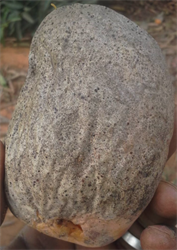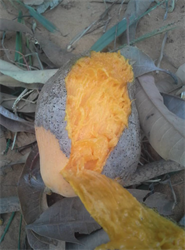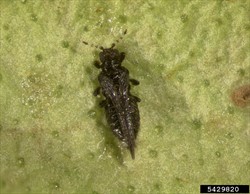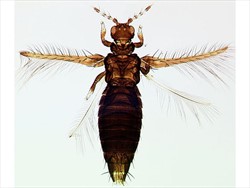- Widespread. Major pest of tropical fruit crops: avocado. Canarium. cashew, guava, mango. mangosteen, rambutan, and more.
- Adult and nymph mouthparts break cells and suck up juices and surface layers turn silvery. Black spots of solidified excreta form where thrips feed, with excess falling on leaves below stimulating growth of sooty moulds. Leaves fall; symptoms on fruit impact sales.
- Eggs, laid without fertilisation on underside of leaves, hatch within 4 days producing creamy-yellow nymphs with two red bands around the middle, and red tipped abdomens. After two non-feeding (pupal) stages adults emerge, 1mm long, with feathery wings. Males rare.
- Spread: on the wind; thrips are poor flyers. Long distance associated with trade of fruit and nursery stock.
- Biosecurity: risk fron imported fruit and nursery stock.
- Biocontrol: natural predators - lacewings, predatory thrips, predatory bugs, weaver ants, Oecophylla sp. (see Fact Sheet nos. 86, 270, 386, 406). Egg parasitoid, Goetheana shakespearei, collected in Indonesia, introduced into Africa, the Caribbean, Hawaii.
- Cultural control: windbreaks around orchards; ensure healthy growth – spacing, nutrition, irrigation, pruning; avoid planting near alternative hosts. Monitor: (i) blue or yellow sticky traps; (ii) tap foliage over white trays or cloth.
- Chemical control: avoid broad-spectrum insecticides: (i) use aggregate pheromone, plus insecticide; (ii) use neem – either commercial product or homemade (see Fact Sheet no. 402); (iv) petroleum oils; (v) biological insecticides - Metarhizum anisopliae, Beauveria bassiana, abamectin.











